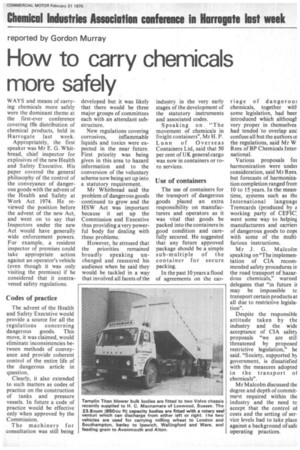How to carry chemicals more safely
Page 21

If you've noticed an error in this article please click here to report it so we can fix it.
reported by Gordon Murray
WAYS and means of carrying chemicals more safely were the dominant theme at the first-ever conference covering the distribution of chemical products, held in Harrogate last week.
Appropriately, the first speaker was Mr E. G. Whitbread, chief inspector for explosives of the new Health and Safety Executive. His paper covered the general philosophy of the control of the conveyance of dangerous goods with the advent of the Health and Safety at Work Act 1974. He reviewed the position before the advent of the new Act, and went on to say that Inspectors under the new Act would have generally wide enforcement powers. For example, a resident inspector of premises could take appropriate action against an operator's vehicle (even though it was only visiting the premises) if he considered that it contravened safety regulations.
Codes of practice
The advent of the Health and Safety Executive would provide a source for all the regulations concerning dangerous goods. This move, it was claimed, would eliminate inconsistencies between methods of conveyance and provide coherent control of the entire life of the dangerous article in question.
Clearly, it also extended to such matters as codes of practice on the construction of tanks and pressure vessels. In future a code of practice would be effective only when approved by the Commission.
The machinery for consultation was still being developed but it was likely that there would be three major groups of committees each with an attendant substructure.
New regulations covering corrosives, inflammable liquids and toxics were expected in the near future. First priority was being given in this area to hazard information and to the conversion of the voluntary scheme now being set up into a statutory requirement.
Mr Whitbread said the problem of dangerous goods continued to grow and the HSW Act was important because it set up the Commission and Executive thus providing a very powerful body for dealing with these problems.
However, he stressed that the priorities remained broadly speaking unchanged and reassured his audience when he said they would be tackled in a way that involved all facets of the industry in the very early stages of the development of the statutory instruments and associated codes.
Speaking on "The movement of chemicals in freight containers", Mr H. P. Lunn of Overseas Containers Ltd, said that 50 per cent of UK general cargo was now in containers or roro services.
Use of containers
The use of containers for the transport of dangerous goods placed an extra responsibility on manufacturers and operators as it was vital that goods be packed into the containers in good condition and carefully secured. He suggested that any future approved package should be a simple sub-multiple of the container for secure packing.
In the past 10 years a flood of agreements on the car riage of dangeronE chemicals, together witt some legislation, had beer introduced which althougt very proper in themselves had tended 'to overlap anc confuse all but the authors ol the regulations, said Mr W Rees of BP Chemicals International.
Various proposals tot harmonization were undei consideration, said Mr Rees. but forecasts of harmonization completion ranged from 10 to 15 years. In the meantime, systems such as the International language Tremcards (produced by a working party of CEFIC, went some way to helping manufacturers and carrier: of dangerous goods to cope with some of the multifarious instructions.
Mr J. G. Malcolm speaking on "The implementation of CIA recommended safety procedures in the road transport of hazardous chemicals," warned delegates that "in future it may he impossible tc transport certain products at all due to restrictive legislation".
Despite the responsible attitude taken by the industry and the wide acceptance of CIA safety proposals "we are still threatened by proposed restrictive legislation," he said. "Society, supported by government, is dissatisfied with the measures adopted in the transport ol chemicals".
Mr Malcolm discussed the degree and depth of commitment required within the industry and the need to accept that the control ol costs and the setting of service levels had to take place against a background of safe operating practices,












































































































